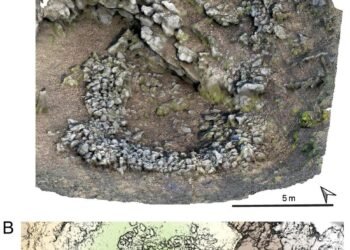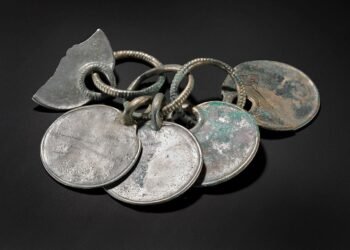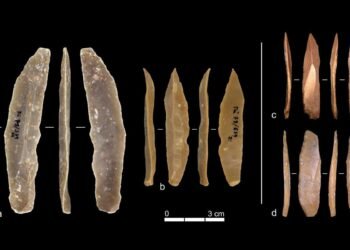During excavations at a 13th-century weaving mill in Tønsberg, a town in Vestfold County, Norway, archaeologists from the Norwegian Institute for Cultural Heritage Research (NIKU) uncovered a spinning whorl—an essential tool in the textile production process—carved with swastika symbols.

The artifact, made of red sandstone, features four swastikas: three right-facing and one left-facing. It was found among various other tools used for spinning and weaving, including loom weights, thimbles, and even a decorated antler object, possibly part of a woven sword. The whorl was discovered between two floor layers of the building, which archaeologists interpret as a weaving room. This space likely hosted various craft activities, from spinning and sewing to weaving, though not necessarily on a large or professional scale.
Hanne Ekstrøm Jordahl, the lead archaeologist and project manager for the excavation, suggested that the swastikas were carved in the Middle Ages, not during the 1940s Nazi occupation, as some might assume due to the modern association of the symbol with Nazism. Jordahl explained, “The context of the find is absolutely certain. The spindle whorl was located between two floor layers in the remains of a house from the 13th century. The swastikas were carved during the Middle Ages.”
Swastikas are an ancient and widespread symbol, known to appear in numerous cultures across Europe, Asia, and the Americas for thousands of years. In Europe, particularly during the Iron Age and Middle Ages, the symbol was used in various forms as a decorative element, as well as a symbol of good fortune and solar energy.

In Norway, the swastika’s use dates back to the Iron Age, with examples found on everything from gold pendants to rock carvings. The swastika is more commonly associated today with Nazi ideology and the negative connotations it carries, but it was initially seen as a symbol of prosperity, security, and the cyclic movement of the sun.
Jordahl noted that swastikas are relatively common in Norwegian archaeology, appearing on artifacts such as gold bracteates and textiles from the Iron Age. However, the combination of a swastika with a spinning whorl is unusual. “So far, we have not found any parallels of swastikas on other spindle whorls,” she said. “But examples of prehistoric swastikas in Norway are not hard to find.”
The swastika’s symbolism in the context of the spinning whorl may relate to rotation and cyclical movement, concepts deeply ingrained in the ancient cultures of Europe. In many cultures, the swastika’s arms, often associated with the rays of the sun, represent the passage of time and the movement of celestial bodies.
Interestingly, archaeological finds like these suggest that swastikas may have also been linked to textile production itself. Spinning, weaving, and sewing were essential components of daily life in medieval Europe, and the swastika could have been used to evoke auspicious meanings related to these activities.
The Tønsberg find is a reminder that symbols and objects, once part of ancient rituals,may acquire new meanings and reveal deeper connections to our shared history.
More information: NIKU























